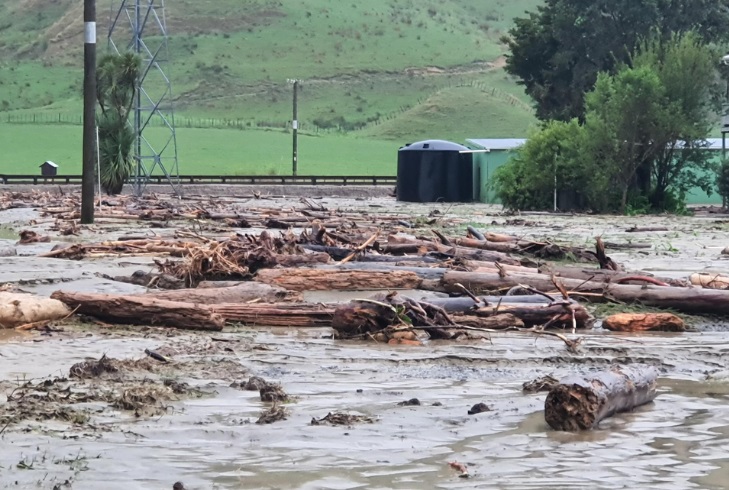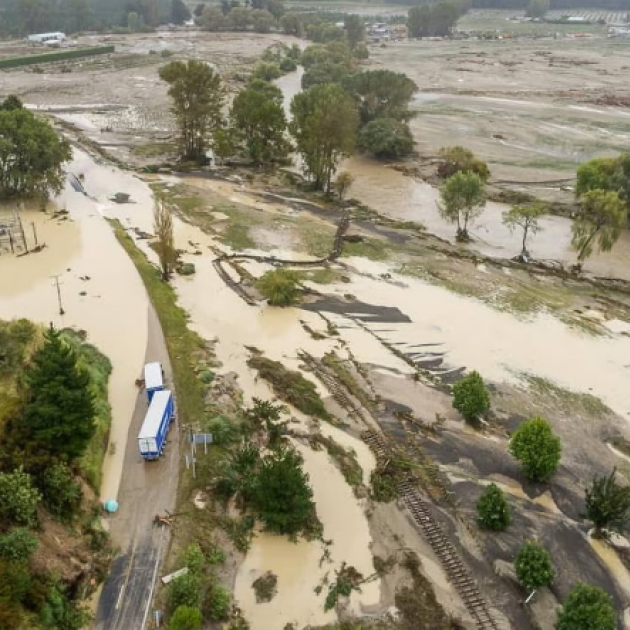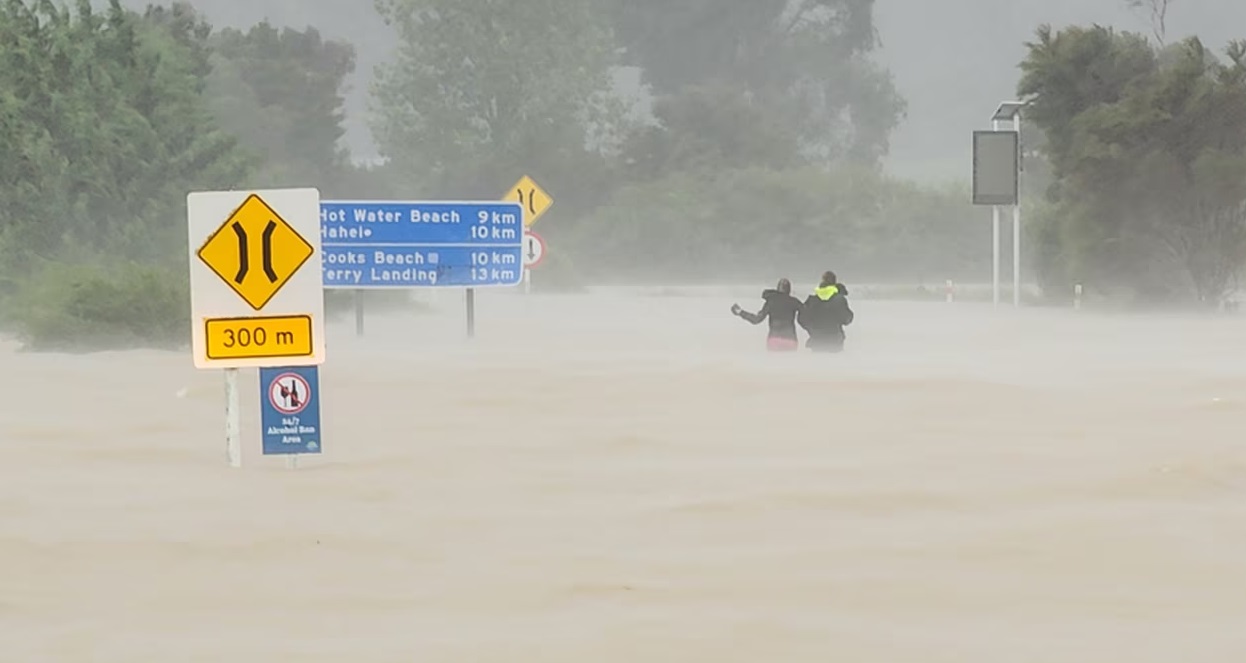Key points
- A national state of emergency has been declared. It is only the third in New Zealand's history.
- Auckland, Northland, Tairāwhiti, Bay of Plenty Region, Ōpōtiki, Whakatāne district, Waikato Region, Thames-Coromandel, Hauraki district, Waikato district, Tararua District, Napier City and Hastings District are under states of emergency.
- Some communities on the east coast of the Coromandel Peninsula are cut off.
- In Auckland there are 27 civil defence centres and shelter sites open.
- Cyclone Gabrielle is expected to continue moving southeast, tracking close to the east coast of the North Island, before moving away to the southeast from late on Tuesday: MetService.
- The Government on Monday unveiled a $11.5 million package to support NGOs and community groups.
- Auckland Airport has cancelled all domestic and international flights for safety reasons.
- Auckland trains are cancelled until at least mid-afternoon on Tuesday
- Interislander cancelled Cook Strait ferry sailings until 2am on Wednesday, and Bluebridge suspended crossings until at least 8.15am on Wednesday.
Prime Minister Chris Hipkins has labelled Cyclone Gabrielle the “most severe weather event this century” as it continues to cause havoc, knocking out power to 225,000 people around the North Island and displacing 2500 Kiwis from their homes.
A national state of emergency was declared this morning as residents and emergency services scrambled to understand the scale of the destruction left behind by Gabrielle.
The cyclone reached New Zealand on Monday and has left North Island regions devastated by flooding, slips and destroyed homes. A firefighter remains missing after a landslide at Muriwai, west of Auckland.
The volunteer firefighters were investigating a flooded house on Motutara Rd when the landslide occurred on a slope above and crushed the house late on Monday night. Emergency services had to make the devastating decision to call off the search for their colleague as the saturated land continued to move and the wind belted the west coast.
Hipkins today sent a message to the fire crew responding to the landslide, saying “our thoughts and hopes are with you”.
Meanwhile, two rescue operations in Hawke’s Bay are under way - one to evacuate RSE workers trapped on a building roof in Hawke’s Bay and another to collect people trapped with their vehicles.
Hipkins said the impact of Gabrielle was significant and widespread, labelling it the worst weather event this century to date. Authorities have been called out to deal with 1800 incidents.
More than 2500 people and families have been displaced from their homes - including 1000 evacuated in the Far North, 400 households in Auckland, 93 in Bay of Plenty, 75 in Waikato and roughly 1000 people in Hawke’s Bay.
Close to 225,000 people are without power on Tuesday night and Hipkins said electricity companies "haven't seen this damage since Cyclone Bola" in 1998. Some cell towers were down and others were operating on batteries that could run out.
Forty-one supermarkets are closed, which Hipkins said those were largely in Northland, Gisborne and Hawke’s Bay. “Please only buy what you need," he urged.
'Not out of the woods yet'
The Prime Minister warned the country wasn’t out of the woods. “We’re still in for a bumpy time ahead,” he said, while acknowledging that the weather was set to improve overall in the coming days.
Schools across big parts of the North Island remained shut and Hipkins said principals would make the call on when they would open.
Earlier, Hipkins said Monday had been a "very big night" for New Zealanders across the country and the cyclone had seen "extensive damage done across the country".
"A lot of families displaced, a lot of homes without power."
He said it would take some time to figure out the extent of the damage but thanked all of those involved in the response. The immediate focus was ensuring people had a roof over their heads and food; the next step would be recovery, which the Government was "fully behind".
"Overnight it's difficult in the dark to find out exactly what's happening. At first light this morning as soon as the extent of the disruption and the damage became clear, advice was provided to the minister and therefore through the minister to me that a state of national emergency should be declared and we acted on that immediately."
The flooding and evacuations come as Cyclone Gabrielle was expected to continue moving southeast as it strikes New Zealand - latest MetService forecasts warned of more “significant heavy rain and damaging winds” today, particularly for the Gisborne region.
The heavy rain is now behind Auckland - but the wind was expected to keep belting parts of that region until red strong wind warning in place until midnight, while other regions were facing further rain and gales.
MetService said Gabrielle would track close to the east coast of the North Island, before moving to the southeast from late on Tuesday.
“This is a widespread and significant weather event. Significant heavy rain and damaging winds are impacting many parts of northern and central New Zealand. In addition, large waves, storm surges and coastal inundation are affecting exposed eastern coasts of the North Island."
Auckland flights cancelled
Auckland Airport has cancelled domestic and international flight operations for safety reasons.
“High winds have forced the suspension of ground handling operations at Auckland Airport from now until midnight, meaning no international or domestic passenger flights can depart or arrive until tomorrow,” the airport said in a statement on Tuesday.
“Safety comes first at Auckland Airport and given current high winds and the need to ensure the safety of everyone working in and around the airport apron areas, ground handling operators have decided to suspend operations for the rest of the night,” Auckland Airport Chief Customer Officer Scott Tasker said.
Air New Zealand had earlier cancelled all domestic flights in and out of Auckland for the remainder of Tuesday due to strong gusts that have been making it difficult for ground staff to service aircraft.
Power out 'for days to weeks'
Transpower has declared a Grid Emergency following the loss of electricity supply to Hawkes Bay and Gisborne. The outage is a result of flooding to the Redclyffe substation following extreme weather from Cyclone Gabrielle. The Unison and Eastland networks that distribute electricity to the region are currently down as a result.
"Due to the current situation, we are not able to receive comms from Redclyffe substation, but it is likely it is underwater. We cannot currently access the site but have a helicopter on standby for further investigation when possible."
"We are advising that the community should be prepared to be without power for days to weeks, rather than hours."

Regions reeling
Trees have come down on homes across Auckland, images of major flooding in the North Island have emerged, including a farm inundated with slash from a forestry above it, and many roads in the North Island are closed, including 14 state highway closures in Thames-Coromandel alone.
Thames-Coromandel Civil Defence Controller Garry Towler said his region had “certainly been pummelled" and described the situation in the region as "carnage".
"Everything that was predicted to happen, happened," he told TVNZ's Breakfast show on Tuesday. "We had over 400mls of rain, together with the gale-force winds. As a result of that, the entire Coromandel is shut down."
There were no major arterial roads open at all, he said, and no access to the peninsula due to major slips.
"The entire Coromandel is totally cut off. There's widespread surface flooding - it is quite bad. We have lost cell phone coverage in Whangamatā and Tairua and many of our coastal communities north and south of Whitianga, including places like Matarangi and Hahei.
”What we know already is there’s mass power outages, entire roading networks are closed and there’s widespread flooding.”

Cyclone Gabrielle then travelled south, drenching Hawke’s Bay and putting parts of Napier underwater. Many residents were told to “evacuate immediately” earlier on Tuesday and move to the nearest hill as flooding worsened.
At 9.20am Hawke’s Bay Today photographer Warren Buckland said Napier was cut off. ”All bridges are gone or severely compromised.”
More than 40 households in Eskdale in the Hawke’s Bay were trapped due to the cyclone Fire and Emergency NZ told 1News.
Near Hastings, workers were standing on the roofs of buildings submerged in floodwaters, waiting to be rescued. The Defence Force helped residents in Napier’s Esk Valley leave their homes - and further north also to get some locals out of Dargaville where a river has burst its banks.

Gisborne was without power, internet and phone coverage on Tuesday and main roads both in and out of the region are blocked. More than two dozen families sought refuge at a local marae after floodwaters threatened their homes. Te Akau o Tokomaru Civil Defence coordinator Lilian Te Hau-Ward said 26 families were evacuated to higher ground last night and were now returning to their homes to assess the damage.

National state of emergency declared
At 8.43am today, Emergency Management Minister Kieran McAnulty signed a declaration ordering a national state of emergency.
This gives the national controller the legal authority to apply further resources across the country and set priorities in support of a national level response.
The declaration applies to the six regions that have already declared a local State of Emergency: Northland, Auckland, Tairāwhiti, Bay of Plenty, Waikato, and Hawke’s Bay.
“This is only the third time in New Zealand history that a National State of Emergency has been declared,” McAnulty said.
”This is an unprecedented weather event that is having major impacts across much of the North Island.”
McAnulty told reporters this was "a significant disaster with a real threat to the lives of New Zealanders".
- NZ Herald and RNZ












